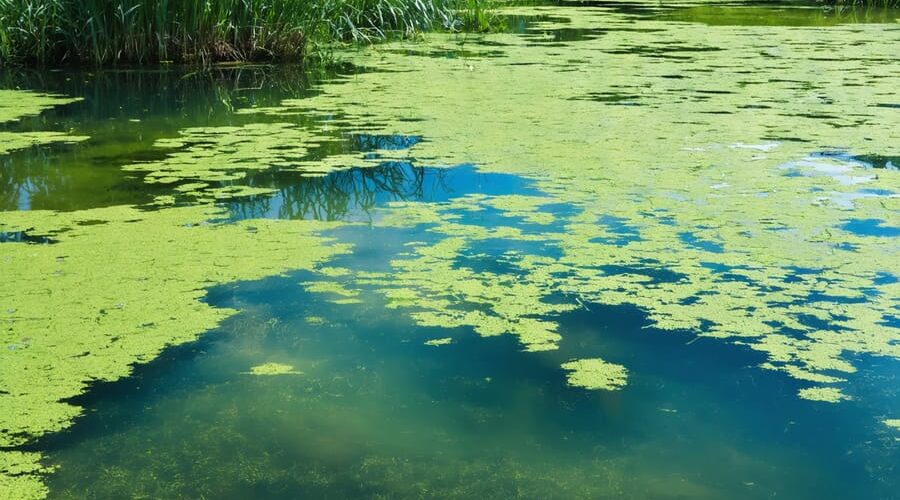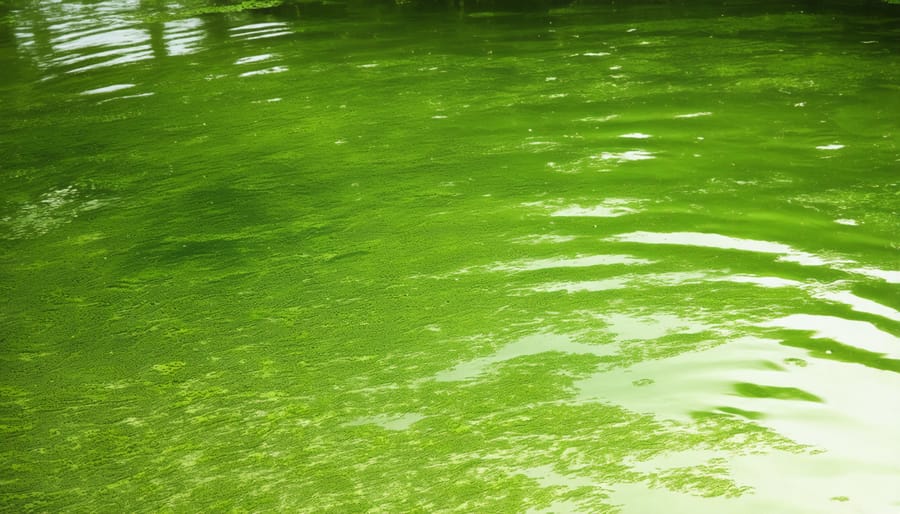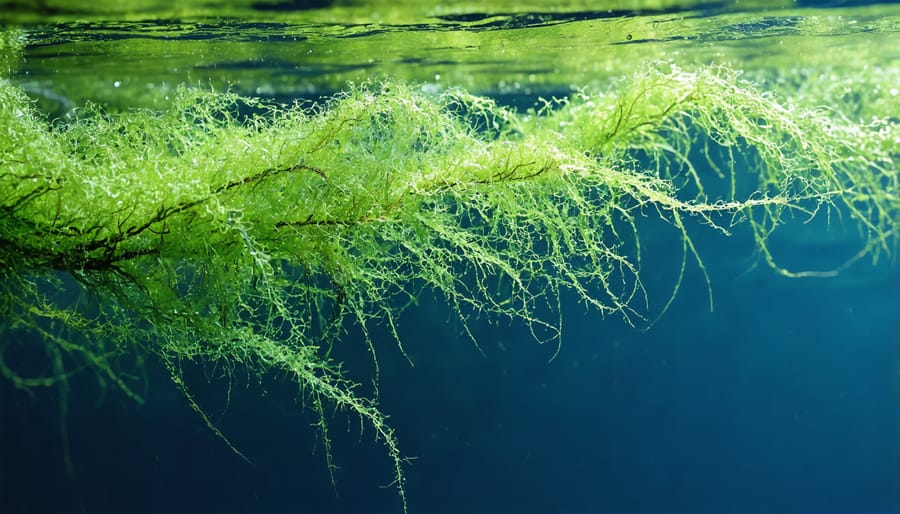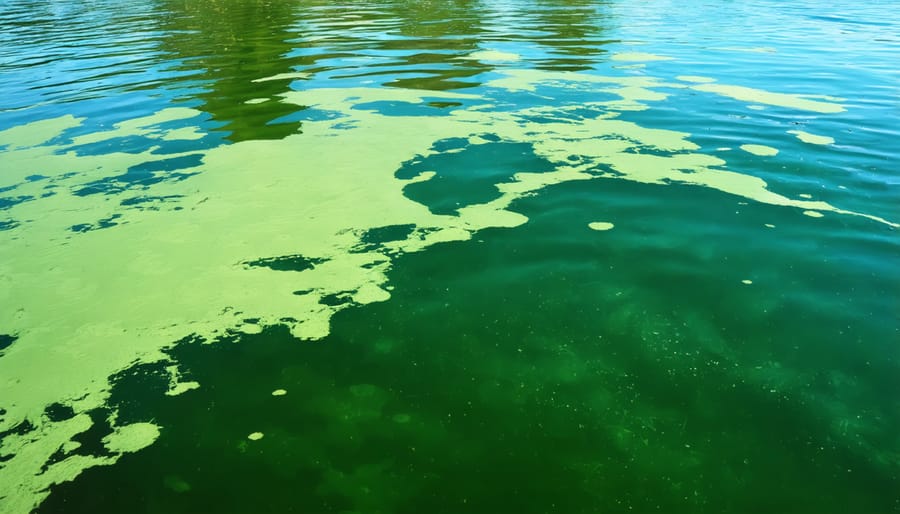
These Deadly Pond Algae Could Destroy Your Water Garden (How to Spot Them)
Vibrant green patches spreading across your pond’s surface signal the arrival of algal blooms – a common yet concerning phenomenon that affects water bodies worldwide. From the toxic blue-green cyanobacteria that threaten aquatic life to the harmless but unsightly filamentous algae that form floating mats, these microscopic organisms can quickly transform crystal-clear waters into murky, problematic environments. While some blooms naturally occur during warm seasons, understanding the different types and implementing natural algae control methods early can help maintain your pond’s health and beauty. Whether you’re dealing with planktonic algae that turn water pea-soup green, or stringy blanket weed climbing up your waterfall, recognizing these common bloom patterns is the first step toward effective management and prevention.
The Green Monster: Planktonic Algae
Visual Signs and Effects
Identifying an algal bloom in your pond is fairly straightforward once you know what to look for. The most common visual sign is a sudden change in water color, typically turning your pond green, reddish-brown, or even bright blue-green. These color changes often appear like someone has spilled paint across the water’s surface.
Look for patches of foam or scum floating on top of the water, which might resemble a thick mat of vegetation. In severe cases, you might notice what looks like green paint or pea soup, especially during warm, sunny days. The water’s clarity will significantly decrease – if you can’t see more than 12 inches below the surface, you likely have an algal bloom.
Other telling signs include:
– A distinctive musty or earthy smell
– Dead fish floating on the surface
– A slimy or gelatinous texture when you run water through your fingers
– Reduced water movement in fountain areas
– Green streaks along the pond edges
During early morning hours, you might notice bubbles on the water’s surface, caused by oxygen production from the algae. As the bloom progresses, you may see clumps of dying algae turning brown or gray, often accompanied by an unpleasant odor.

Risk Factors
Several key factors can trigger algal blooms in your pond or water feature. The most common culprit is excess nutrients, particularly nitrogen and phosphorus, often from overfeeding fish or decaying plant matter. When you don’t maintain proper water balance, these nutrients become perfect fuel for algae growth.
Sunlight exposure plays a crucial role too – intense sunshine combined with warm temperatures creates ideal conditions for algae to multiply rapidly. Poor water circulation is another major factor, as stagnant water allows algae to settle and flourish without disruption.
Weather patterns can significantly impact bloom formation. Heavy rains can wash additional nutrients into your pond from surrounding soil, while extended periods of hot, calm weather create perfect conditions for algae development.
The shape and depth of your pond matter as well. Shallow areas warm up quickly and receive more sunlight, making them prime spots for algae growth. Even the materials used in pond construction can influence blooms – concrete and certain stones can leach minerals that feed algae.
Understanding these triggers helps you spot potential problems before they become serious issues in your water feature.
String Algae: The Pond Strangler

Identification Features
Spotting an algal bloom isn’t as tricky as you might think once you know what to look for. The most common sign is a sudden change in water color, typically turning your pond green, brown, or even reddish. These blooms often appear as a thick, paint-like layer floating on the surface, sometimes resembling spilled soup or pea soup.
In home ponds and small water features, you’ll usually notice string algae first along the edges or around rocks. These look like long, stringy green threads that wave in the water. They feel slimy to touch and can quickly form thick mats that wrap around plants and equipment.
During warm, sunny days, you might spot bubbles forming in these algal mats – that’s photosynthesis in action! The water might also develop an unpleasant musty or earthy smell. In larger bodies of water, blooms often start in shallow, warm areas where sunlight easily reaches the bottom.
Keep an eye out for changes in water clarity too. If you can’t see more than 12 inches deep into your pond, there’s a good chance you’re dealing with an algal bloom. Morning hours are usually best for spotting these changes, as algae tend to be more visible at the surface early in the day.
Environmental Triggers
Algal blooms thrive when specific environmental conditions align, creating the perfect storm for rapid growth. The most significant trigger is excess nutrients in the water, particularly nitrogen and phosphorus, often from fertilizer runoff, decomposing leaves, or fish waste. When these nutrients combine with warm water temperatures (typically above 60°F), algae can multiply rapidly.
Sunlight plays a crucial role, as most algae species need abundant light for photosynthesis. This explains why blooms frequently occur during long summer days. Poor water circulation is another key factor, as stagnant water allows nutrients to concentrate in specific areas and provides ideal conditions for algae to establish themselves.
Weather patterns also influence bloom formation. Heavy rains followed by warm, sunny periods can wash nutrients into water bodies and create ideal growing conditions. Additionally, low water levels can concentrate nutrients and raise water temperatures, making blooms more likely.
Changes in pH levels can trigger blooms too. Most problematic algae prefer slightly alkaline conditions, though some species can thrive in more acidic environments. Understanding these triggers helps pond owners take preventive measures before blooms become established.
Blue-Green Menace
Warning Signs
Recognizing toxic blue-green algae blooms early can help you protect your pond and its inhabitants. The most obvious sign is a distinctive blue-green or greenish-brown coloration on the water’s surface, often resembling spilled paint or thick pea soup. You might notice small flecks or larger clumps floating near the surface, especially along the shoreline or in calm areas.
Keep an eye out for sudden changes in water clarity or color. If your pond water turns murky overnight or develops an unusual tint, this could indicate the start of a harmful bloom. A strong, unpleasant odor – often described as musty, earthy, or like rotting plants – is another telltale sign.
Watch for changes in your pond’s ecosystem too. Fish swimming near the surface and gasping for air could indicate declining oxygen levels caused by algal blooms. Dead fish or other aquatic life are serious warning signs that shouldn’t be ignored.
Surface scum that looks oily or creates a film on the water is particularly concerning. Try this simple stick test: poke the suspicious growth with a long stick. If it breaks apart into small clouds or particles, it’s likely blue-green algae. If it comes up in stringy strands, it’s probably harmless filamentous algae.
Remember, when in doubt, treat any suspicious algal growth as potentially toxic and keep pets and children away from the water until you can get it properly tested.

Health Risks
While algal blooms might look harmless, they can pose serious health risks to both aquatic life and humans. The most dangerous type comes from blue-green algae, also known as cyanobacteria, which can produce harmful toxins. These toxins can be deadly to fish, causing mass die-offs in ponds and lakes when blooms become severe.
Pet owners should be especially cautious, as dogs are particularly vulnerable. Dogs might drink from or swim in contaminated water, or even eat dried algae along the shoreline. This exposure can lead to severe illness, liver damage, and in some cases, death within hours of contact.
For humans, the risks range from mild to severe. Skin contact with toxic algae can cause rashes, itching, and blistering. Swimming or wading in affected water might lead to eye irritation, sore throat, and allergic reactions. If contaminated water is swallowed, symptoms can include headaches, fever, diarrhea, and severe stomach problems.
It’s crucial to keep children away from waters experiencing algal blooms, as they’re more likely to accidentally swallow water while playing. During blooms, avoid all water activities and keep pets away from the water’s edge. If you suspect exposure, rinse thoroughly with clean water and seek medical attention if symptoms develop.
Remember, not all algal blooms produce toxins, but it’s impossible to tell just by looking. When in doubt, stay out!
Early Warning Systems
Recognizing the early signs of an algal bloom can help you take action before the situation becomes serious. The first telltale indicator is often a subtle change in water color, typically shifting from clear to a slightly cloudy or tinted appearance. This change might happen gradually over a few days, making it easy to miss if you’re not checking your pond regularly.
Keep an eye on your pond’s surface during sunny days. If you notice small green particles suspended in the water that seem to intensify with sunlight, this could signal the beginning of a bloom. These particles often start appearing near the edges of the pond where water movement is minimal.
Another important indicator is changing oxygen levels, which you might notice through fish behavior. If your fish are gasping at the surface more frequently than usual, especially in the early morning, this could indicate developing excess nutrient problems that promote algal growth.
Water temperature changes can also herald an approaching bloom. During warm spells, particularly in spring and early summer, check your water temperature regularly. Temperatures consistently above 68°F (20°C), combined with bright sunshine, create ideal conditions for algae proliferation.
Monitor your pond’s plants as well. If you notice that underwater plants are developing a slimy coating or your decorative rocks are becoming unusually slippery, these are classic warning signs. Additionally, pay attention to any unusual odors – a musty or earthy smell often precedes visible algal growth.
Testing your water parameters regularly is crucial. An unexpected spike in pH levels or increasing phosphate readings can indicate that conditions are becoming favorable for algal growth. Keep a log of these measurements to help identify patterns and predict potential blooms before they become severe.
When to Take Action
Knowing when to take action against algal blooms is crucial for maintaining a healthy pond ecosystem. The key is to monitor your water regularly and look for specific warning signs that indicate a developing problem.
For green water algae, intervention becomes necessary when visibility drops below 12-18 inches. Try the arm test – if you can’t see your hand when submerging your arm up to your elbow, it’s time to act. String algae requires attention when it covers more than 20% of your pond’s surface or begins forming thick mats that could affect fish or plant health.
Watch your fish’s behavior closely. If they’re gasping at the surface, especially in the early morning, this could indicate dangerous oxygen levels due to excessive algae. This situation demands immediate action, including implementing proper pond aeration.
Red flags that require urgent intervention include:
– Sudden changes in water color (especially to reddish or brown hues)
– Strong, unpleasant odors
– Dead fish or aquatic life
– Thick, paint-like surface scum
– Visible algal mats spreading rapidly
For small ponds, consider taking action when algae covers more than a quarter of the surface area. In larger bodies of water, intervention might be necessary when algal coverage exceeds 30-40%. Remember, it’s always easier to manage algal blooms in their early stages rather than waiting until they become severe problems.
If you notice these signs, start with natural control methods like reducing nutrient inputs and increasing water movement before considering chemical treatments.
Staying vigilant and recognizing the early signs of algal blooms is crucial for maintaining a healthy and beautiful pond environment. As we’ve explored, these blooms can appear in various forms, from the fuzzy green mats of filamentous algae to the murky pea-soup appearance of planktonic blooms. Remember that while some algae are natural and beneficial, excessive growth can quickly become problematic for your pond’s ecosystem and its inhabitants.
Regular monitoring of your water’s appearance, clarity, and color can help you catch potential issues before they become severe. Pay special attention during warm, sunny periods when algal blooms are most likely to develop. If you notice any sudden changes in your pond’s appearance or unusual algal growth, taking prompt action can prevent the situation from worsening.
By understanding these different examples of algal blooms and their characteristics, you’re better equipped to maintain the delicate balance in your pond. Keep in mind that prevention through proper pond maintenance and water quality management is always easier than dealing with a full-blown algal bloom crisis.
